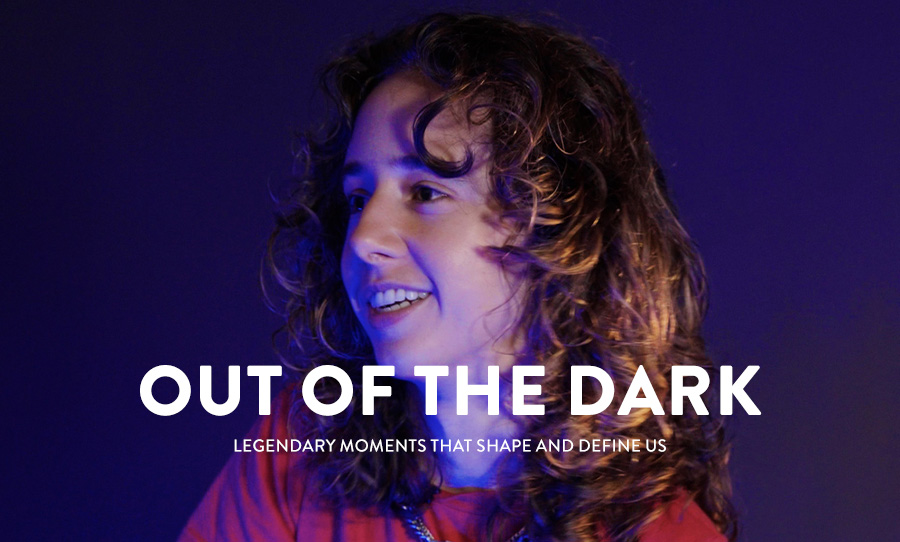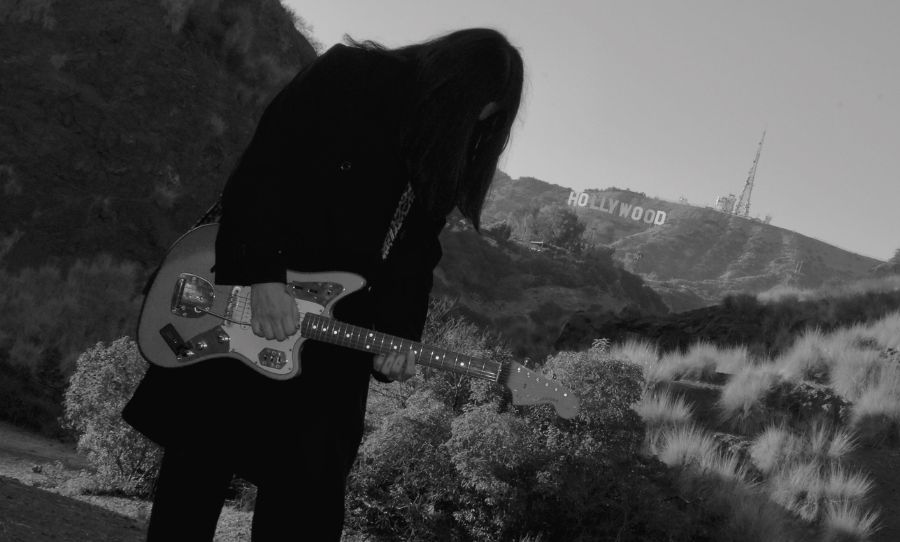We took five with award-winning producer Dean Tuza to chat about the awesome artists he’s worked with, the gear that he loves and what he’s working on next.
Dean Tuza is an award-winning producer, engineer, songwriter and multi-instrumentalist. If you’re into good Australian music then you’ve definitely heard his stuff; he’s worked a whole bunch of incredible emerging artists like Stella Donnelly, MOSSY, Leroy Francis, DEN, Publique – the list goes on. He was also instrumental in the rise of The Rubens when they were causing a stir back in 2011.
We caught up with Dean to find out a little more about how he got into producing, some of the gear he’s frothing at the moment, and what he’s working on right now (it’s a lot).

ENMORE AUDIO: Tell us a bit about your studio space. What do you love about it?
DEAN: I love it because it’s at home!
My current studio is in a town called Toorak in Melbourne. It’s on a nice leafy street. It has a spare room for the artists to crash in. Everyone that comes over really loves the space and feels at ease. I installed a 8’x6′ booth. It sounds great inside. I even track drums in it when I’m not at a big studio. All of the equipment and instruments are wired into the patch bay and are ready to record instantly.
I have spent the past 10 years working in some pretty crazy places. From basements in NYC to boats in London to underground bunkers in Sydney. I’ve had a nice studio where I had to worry about rent and utilise every second to make money and an old cottage where the electricity would turn off because mice chewed through a cable (again).
ENMORE AUDIO: What are you currently working on?
DEAN: I just finished producing the debut Stella Donnelly album in Perth at a great studio called Tunafish Recordings. At the moment I’m listening back to Moody Beach EP mixes/masters (they are sounding awesome). I am also right in the middle of MOSSY‘s debut album.
ENMORE AUDIO: What is the first thing that really got you into recording music?
DEAN: When I was in year six (1996) I got my first guitar. My guitar teacher was a uni student and a super great guy (he is actually a rocket scientist now in the UK). He was really into punk music so we started playing things like Minor Threat, Gorilla Biscuits, Fugazi, Agnostic Front, Mad Ball, Toe To Toe etc. He would make me cassettes or I’d just play along to songs from skate vids.
I didn’t have a very loud guitar amp so I would plug directly into the line/microphone input on my cassette deck and blast it. I later realised if I plugged the outputs into my portable cassette deck I could record myself playing along. That’s where it started…. from just trying to play in time with all these bands and record it to show my teacher.
ENMORE AUDIO: How do you approach a fresh session with an artist?
DEAN: It always varies but I usually start out on keys and I just throw on a pad sound (usually something on my Ensoniq ASR10). I also collect rhythm boxes. They are always plugged in and ready to record. Things like Roland CR68/78 CR5000/8000, TR77 etc. They are great tools to find tempos and kick/snare/hat rudiments.
They are also really easy for the artist to experiment with and find rhythm combinations that they love. Once we have found a tempo and a couple of chords that we are vibing on we can think about topline melody and counter-point. From the very second we sit down everything is recording. On so many songs, something from the first session has ended up on the final master.
ENMORE AUDIO: What are some pieces of gear that have become central to your workflow?
DEAN: MADI [Multichannel Audio Digital Interface] – I’m surprised how uncommon this is in Australia. I use an RME Madiface XT connected to two SSL Alphalinks. I have 48 channels analog and 48 digital simultaneously. The Totalmix software lets me route any signal to anywhere I like. So all of my processors and effects are connected and ready.
For example, MOSSY likes to sing into and manipulate a pitch shift pedal and Space Echo.
I can route the dry vocal into Totalmix and back out to the pitch shift pedal with zero latency because of its pre-convertor (just like a digital patch bay). Then I submix both signals to be drenched in Space Echo all controlled in real time by MOSSY in the booth. All without a mixing desk or crazy latency/phase.
It’s also super cool to create multiple submixes and slam stuff to different tape machines simultaneously (or in the case of the Studer 24 track I send three different submixes hitting the tape at different volumes). Then I just choose what sounds best coming off tape.
ENMORE AUDIO: Are there any pieces of gear that have been really inspiring you lately?
DEAN: I use this more of a utility device but the new MPC Touch is awesome. I use it as my second computer screen and also put it in the booth if the artist needs a screen whilst performing. Its awesome because it is now my central MIDI hub and can change any patch on ALL my MIDI Devices. So I can have my keyboards in another room and just scroll through the keyboard’s patches. Super fun!
ENMORE AUDIO: Is there anything you’re really hanging out to buy at the moment?
DEAN: I just got a Creation Audio LZ1 from a friend in NYC. They are so handy and the impedance control helps so much when hitting guitar pedals. It also frees up my pre-amps for other things.
A friend just introduced me to one of these Fairfeild Circuitry Four Eyes pedals on my kick and snare submixes when we were recording our own drum samples for an album. So good I’m gonna get one!
ENMORE AUDIO: Software or hardware – what do you prefer and why?
DEAN: Both are great for different applications! I have a weakness for hardware. On certain projects hardware is just plain old better! For example, today I plugged in my Oberheim Matrix 1000 (patch number 718) to Tascam 234 four track (bammmmm, keeper bass tone – the artist signed off on it instantly).
ENMORE AUDIO: What are some of your techniques for getting over a creative roadblock?
DEAN: Bum In Chair! I just know that I’m not always going to be inspired. But at the end of a 90-minute power sesh I nearly always walk away happy or with a clearer idea of what I like or don’t like. Sometimes making good stuff takes loads of time and iterations. Sometimes you get lucky and it sticks early on. Either way. Just keep coming back and put ya bum in the chair.
ENMORE AUDIO: What the cheapest piece of gear that you feel like you’ve gotten the most out of?
DEAN: On Stella Donnelly’s album she was recording live with a full band all to tape. Stella has a super loud voice (AMAZING VOICE), and she can sometimes blow out the mic with plosives but they are really high – around 1khz.
I tried every microphone on her voice for band applications. Turns out we used a vintage Shure Unisphere 565sd. It costs like $100. For this application it beat out every microphone, including some super expensive ones. It also reduced the plosives by 95%. Great microphone.
ENMORE AUDIO: What do you find always challenges you in the studio – how do you overcome it?
DEAN: Lots of things challenge me in the studio…. depends what time of day or night
Something I have been actively working on is session file management (sounds boring but its SO important). When you start working across albums at different studios and writing with multiple artists files can add up and get super confusing. I was losing so much time searching for files. I researched and experimented non stop with different systems. I ended up going with the Grammy file hierarchy system.
I do everything on this Grammy recommendations sheet. My assistant Jacob has taken it a step further with colour coding and his own folders so he doesn’t ever stuff up my original sessions when he backs up my drives.
I also use Auddly for all song sharing and track comments. I name the songs the exact same as my DAW session so when the artist/A&R/whoever refers to a song I can instantly open my Protools or Ableton session and keep working from there.
ENMORE AUDIO: Do you have any producer or engineer heroes? What is it about them that you love?
DEAN: Ohhhhhh sooo many! And the list is always getting longer. I have been really lucky to work with some producers and engineers that have become my super special to me.
People like Stuart White (Beyonce/Jay Z), who is an engineer/mixer. Stu was in the studio next to me in NYC. He is such a hard worker. Crazy talented and incredibly humble! He would come hang out in our basement studio (where The Strokes recorded Is This It). He taught me so much about workflow and mixing!
I’d love to meet Rick Rubin and Nick Launay. They just seem like kind people that are doing incredible work!
Here is a Sonic Scoop Vid of Stu Breaking down his mix on one of my productions.
ENMORE AUDIO: Who are some artists that you’ve really enjoyed working with and why?
DEAN: I have enjoyed working with them all. They are all so different. I learn so much from them!
I don’t think I have ever laughed as hard ever in my life as doing a These New South Whales album.
I started tearing up listening back to Stella Donnelly’s album.
Leroy Francis will make sure you are as hyperactive as him in the studio 24/7.
The list goes on.
It’s all pretty cool because a lot of the different artists I work with become friends and play in each other’s bands or on their records. It’s really nice.
ENMORE AUDIO: What are some of your goals?
DEAN: My ultimate goal is just to make the artists happy. There can be so much pressure placed on an artist in so many different ways! My goals have to be aligned with the artist. I’m just trying to keep figuring out ways to help them get to where they want to go.


